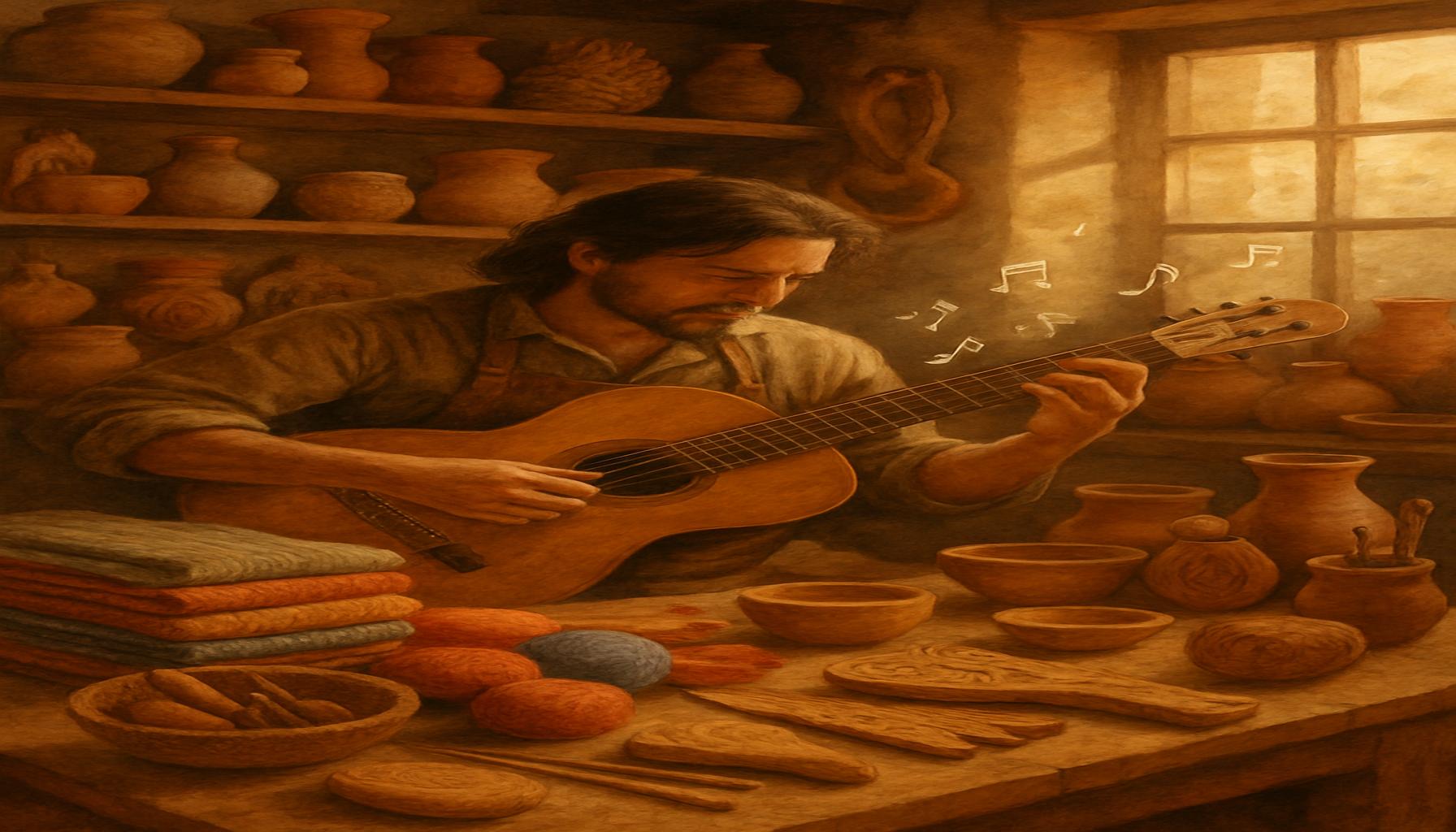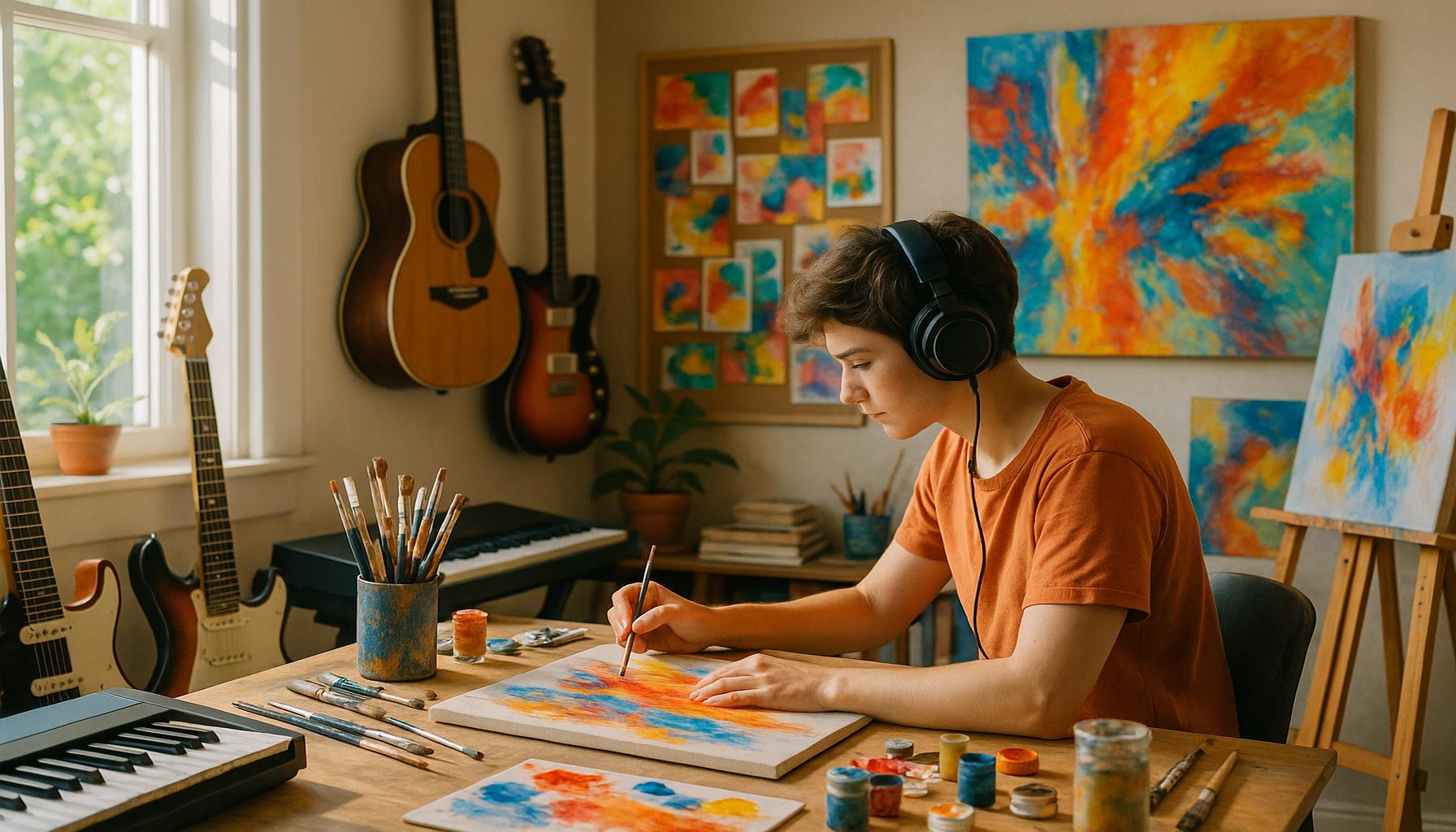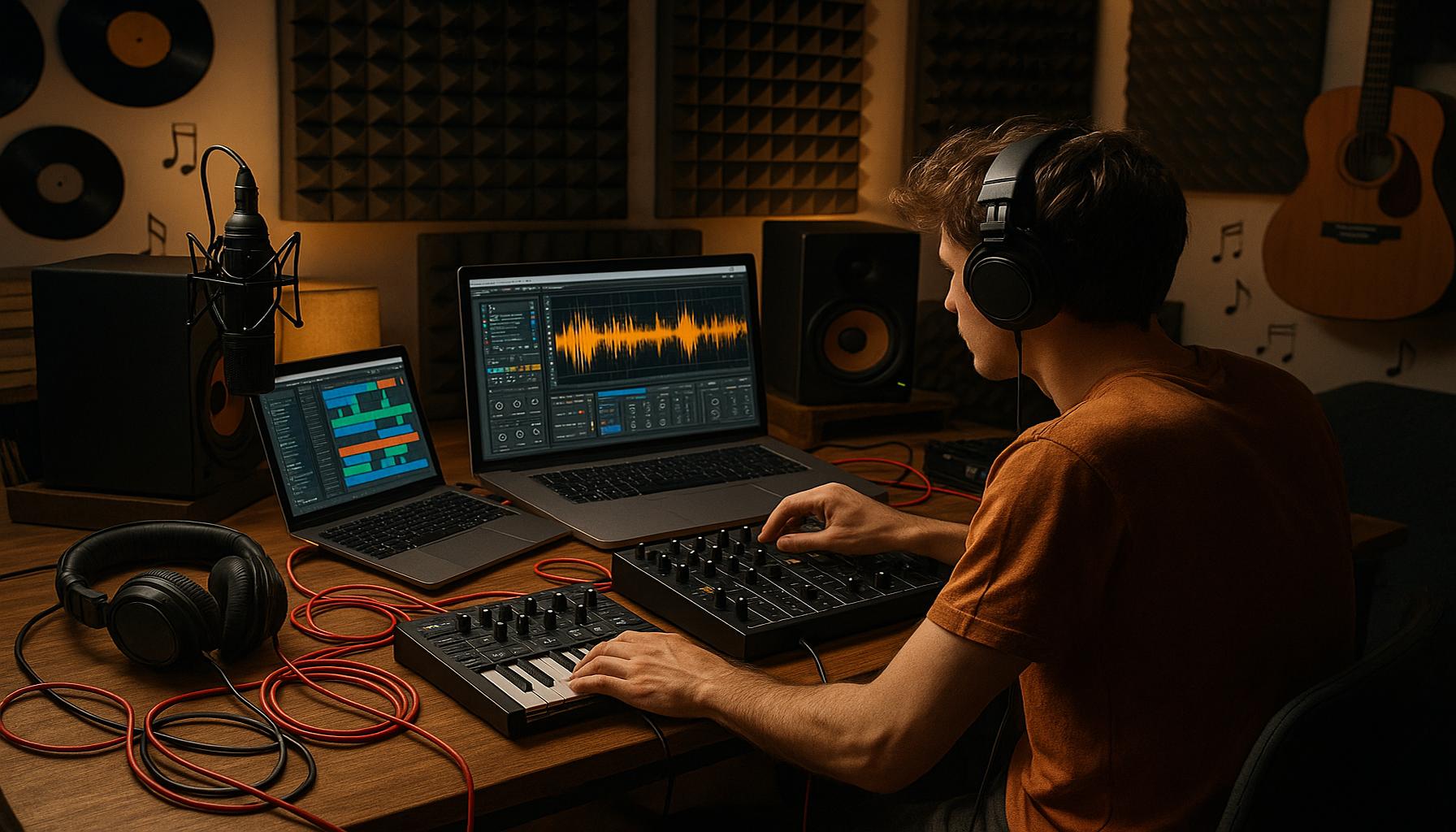The Role of Music in Shaping the Aesthetic of Handmade Crafts and Artisanal Goods

The Tangible Connection Between Sound and Craft
Throughout history, the union of music and art has revealed itself in myriad ways, establishing a rich landscape where creative expressions coexist and inspire each other. In the realm of handmade crafts and artisanal goods, this synergy becomes even more pronounced. Artists and artisans often find that melodies, harmonies, and even lyrics resonate with the essence of their creation, infusing their work with a unique vibrancy. For example, a potter might find inspiration in the soothing tones of a classical symphony, while a woodworker may channel the energy of rock music into dynamic designs.
The integration of musical elements profoundly informs the aesthetic of handmade items. Consider how emotional resonance plays a pivotal role in aesthetic choices. An artist might select a specific color palette based on the feelings a particular song evokes; calming blues and greens might emerge from a gentle ballad, while vivid reds and yellows could reflect the intense passion of a lively Latin piece. This emotional landscape can manifest in various forms, making each craft not only visually appealing but also emotionally impactful.
Cultural influences also permeate the fusion of music and craft. Genres such as jazz, folk, and blues, deeply rooted in American culture, often inspire specific motifs used in textile patterns or pottery designs. For instance, an artisan creating a quilt may utilize motifs that reflect the storytelling nature of folk music, incorporating symbols and images synonymous with community and tradition. This relationship is vital, as it allows craftspeople to celebrate and maintain cultural identities through their creations.
Moreover, the notion of rhythmic patterns in both music and craft highlights the importance of tempo and flow. The act of weaving, for instance, can mimic the rhythms of a drumbeat, with each movement deliberate and intentional. This rhythmic connection can enhance the crafting process, as creators often find that their hands move in tandem with the beats that play in the background, resulting in a seamless blend of sound and sight.
Beyond influencing the final output, music serves as a crucial element in the creative processes of artisans. Many artisans employ music to enhance focus during long hours of crafting. A steady instrumental track can drown out distractions and encourage deep concentration. Furthermore, certain genres of music, such as ambient or electronic, have been shown to boost creativity, allowing artisans to brainstorm innovative designs and new techniques freely. Lastly, the right music can set the mood for the workspace; a lively tune might energize a maker, while gentle melodies can create a serene atmosphere conducive to thoughtful creation.
By exploring the intricate relationship between music and handmade crafts, we reveal an exquisite tapestry where sound and sight come together harmoniously. This interplay not only deepens our appreciation for both arts but also opens new channels for creative expression, prompting artisans and enthusiasts alike to delve deeper into the inspiring world of craftsmanship informed by music.
DISCOVER MORE: Click here to dive deeper
Creative Soundscapes: The Symbiotic Relationship of Music and Handmade Artistry
As artisans engage with their materials, music provides an ever-present backdrop that can profoundly influence the aesthetic decisions made during the creative process. Whether they are creating intricately designed jewelry, hand-carving furniture, or crafting beautiful homeware, the presence of music can foster a deep emotional connection between the artisan and their craft. The perceived influence of tempo, for instance, can directly correlate with the artisan’s workflow and artistic expression. Rhythms that energize can lead to quick, bold strokes of creativity, while softer melodies might encourage careful, intricate work.
Furthermore, the role of music genres in shaping an artisan’s creative environment cannot be understated. Different types of music carry with them distinct vibes that can significantly impact the mood and energy of a workspace. For example:
- Classical Music: Often associated with focus and fluidity, classical music can provide a calming influence that aids in precision-oriented crafts like pottery and fine woodworking.
- Folk and Traditional Music: These genres often invoke sentiments of heritage and cultural legacy, encouraging artisans to create pieces that resonate with their personal history or community background.
- Electronic Beats: The driving rhythms and experimental sounds of electronic music may inspire younger, contemporary artisans to push boundaries, creating pieces that reflect modern aesthetics while intertwining traditional techniques.
The physical act of creating, whether through knitting, sculpting, or painting, is often rhythmic in nature, mirroring that of the music being played. This intrinsic connection between movement and sound not only enhances the physical act of making but also enriches the emotional depth of the finished product. An artisan may pour their feelings into their work, with each note of their soundtrack triggering a particular emotion that gets channeled into their craft.
In addition, music as a source of inspiration goes beyond mere accompaniment. It can evoke memories, spark ideas, and serve as a narrative thread in the storytelling inherent in handmade crafts. For instance, a textile artist might choose a fabric pattern that reflects the lyrics of a powerful song, embedding layers of meaning into their work. These narratives foster a unique dialogue between the artist, their creation, and the consumers who engage with these objects.
Utilizing music as a catalyst for creativity is not limited to individual artisans. Crafting communities often come together in harmony, sharing playlists and discovering how collective musical experiences can enhance the crafting process. Events like local craft fairs or workshops frequently incorporate music, offering a shared auditory experience that allows artisans to connect not only with their craft but also with each other, deepening the community fabric they are a part of.
Ultimately, recognizing the role of music in shaping the aesthetic of handmade crafts and artisanal goods invites us to appreciate the multifaceted dimensions of art making. It opens doors to understanding how sound, emotion, and craftsmanship coalesce, encouraging both artisans and consumers to see and feel the stories embedded within every handmade piece.
The intersection of music and handmade crafts is a fascinating exploration that reveals much about cultural expression and aesthetics. Music has the power to influence the creative process, acting as both a backdrop and a catalyst for artisans and crafters as they bring their visions to life. Various musical genres can inspire artisans in different ways, shaping the emotional resonance of their work. For example, the harmonious tunes of classical music might encourage precision and detail in a delicate ceramics piece, whereas upbeat folk melodies may inspire vibrancy and boldness in colorful textiles.
Moreover, the aesthetics of handmade crafts are often steeped in cultural narratives that mirror local musical traditions. Artisans may incorporate traditional songs or rhythms into their creative process, grounding their work in cultural heritage while evoking a sense of community and history. This symbiotic relationship not only enhances the aesthetic appeal of the crafts but also promotes the values and stories behind them. Each piece becomes a testament to the music that inspired it, fostering a deeper connection between the artist, the craft, and the audience.
To further showcase this relationship, consider exploring how different artistic movements have played a role in shaping overall craft aesthetics. For instance, the Arts and Crafts movement of the late 19th century was heavily influenced by folk music, emphasizing natural materials, handmade quality, and a return to simpler forms of craftsmanship. This movement not only revived interest in traditional arts but also influenced how music shaped the aesthetics of everyday items like furniture, pottery, and textiles.
| Inspiration from Music | Cultural Narratives |
|---|---|
| Music as a Creative Catalyst | Ties between Music and Cultural Heritage |
| Varied Genres Impacting Aesthetics | Storytelling through Craft |
As we delve deeper into this topic, the combination of tactile craftsmanship and auditory inspiration offers an expansive field of study. It encourages not only artisans but also enthusiasts to reflect on how sound can shape color, form, and texture in handmade goods. Understanding this dynamic relationship opens the door to a richer appreciation of the crafts we often take for granted in our daily lives.
DIVE DEEPER: Click here to explore the evolution of digital art
The Sound of Collaboration: Music in Crafting Communities
Within the realm of handmade crafts, the collaborative spirit is profoundly enhanced by music. Artisans often gather in studios, co-ops, or community events, where the shared experience of crafting becomes intertwined with a curated soundscape. This collective immersion not only amplifies individual creativity but also helps forge bonds that strengthen the artistic community. For many, these musical gatherings contribute to what can be termed a community aesthetic, where the collective influence of different crafts harmonizes under a common melodic theme.
One notable example is the “Maker Movement,” which has gained momentum across the United States. These events, characterized by the melding of music and craft, provide artisans with a platform to showcase their work while simultaneously enjoying a tapestry of live performances. From DIY craft fairs in vibrant neighborhoods to larger artisan festivals such as CraftBoston, the sonic elements of these gatherings play a pivotal role in crafting not just artifacts, but also shared experiences that transcend individual art pieces. Music acts as a social glue, enhancing interactions among creators, customers, and the environment.
Moreover, the interplay between cultural influences and music can rarely be overlooked. Handmade crafts often serve as vessels for cultural expression, reflecting traditions that have been passed down through generations. Artisans may draw inspiration from the folk music of their heritage, allowing these sounds to inform the choice of motifs, colors, and techniques in their work. For instance, Native American artisans may incorporate rhythmic chants and traditional songs as they bead, weaving the auditory history of their culture directly into the fabric of their goods.
The music that accompanies the crafting process isn’t just a mere background accessory; it can also manifest in the form of sound patterns that influence the final outcome. Considerings rhythms in craft-making—whether it be hammering, sewing, or weaving—artisans find themselves subconsciously syncing their movements with the beat of their favorite tunes. This internal rhythm aids in creating pieces that not only carry visual allure but also an inherent musicality, reflecting the symphony of the creation process.
Furthermore, the globalization of music has introduced artisans to diverse sonic landscapes, allowing them to explore and incorporate various genres into their creative practices. From Afrobeat-inspired patterns in textile designs to the incorporation of reggae-infused styles in wooden carvings, the blending of music and craft helps to spawn innovative hybrid forms that challenge traditional boundaries. This cultural exchange nurtures a rich tapestry of artistic interpretations that are continuously evolving.
In addition, the significance of curated playlists cannot be dismissed in modern craft practices. Many artisans are now creating themed playlists to align with their work, adjusting the sound environment based on the project at hand. A glassblowing session may be accompanied by upbeat jazz, while a long night of leatherworking could benefit from ambient electronic sounds. This customization reflects an awareness of how music can subtly guide mood and productivity, providing yet another layer of engagement in the crafting experience.
As we explore the multifaceted relationship between music and handmade artistry, it becomes increasingly clear that sound is more than an influence—it’s an essential thread. The emotive resonance created by carefully chosen soundscapes enriches not only the artistic process but also the deeper stories behind each handcrafted item, inviting us to appreciate the intricate narratives woven into every aspect of artisanal goods.
DIVE DEEPER: Click here to discover more
Conclusion: Harmonizing Craft and Sound
In summary, the intricate relationship between music and handmade crafts weaves a narrative that transcends auditory experience, merging creativity, culture, and community. As explored, music serves not only as an inspirational backdrop for artisans but also as a vital source of communal bonding and cultural expression. The collaborative nature of crafting events, such as those found in the thriving Maker Movement, illustrates how musicians and artisans come together to create a rich, shared atmosphere that fosters innovation and passion. This synergy enhances the aesthetic appeal of artisanal goods, layering additional meaning into each piece created.
Moreover, the role of cultural influences through music manifests in the motifs and techniques employed by artisans, echoing the rhythmic patterns that they incorporate into their crafting processes. The ongoing globalization of music has broadened these horizons, allowing artisans to experiment with eclectic musical styles that further enrich their work. The thoughtful curation of playlists tailored to specific projects reflects a growing understanding of how sound can elevate the crafting experience, influencing not only mood and productivity but also the end result.
In a world where handmade crafts often symbolize individuality and authenticity, the incorporation of music deepens our understanding of these artistic endeavors. Each crafted item tells a story, one that harmonizes with the tunes that inspired its creation. As we continue to explore the evolving landscape of artisanal goods, let us recognize the essential role that music plays—an unseen brush that strokes life into the very essence of handmade artistry. The next time you admire a handcrafted piece, consider the melodies that may have accompanied its creation; therein lies a rich tapestry of creativity, culture, and community waiting to be uncovered.


